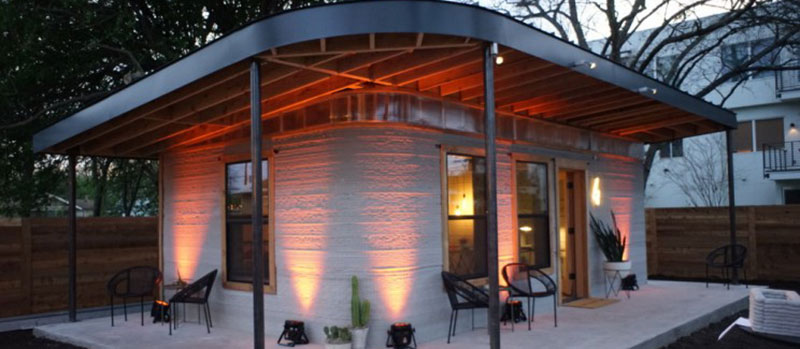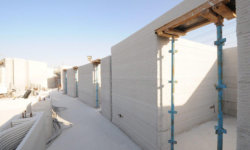Construction printing has seen a lot of great initiatives in the past few years, from 3D printing drones to massive cable driven, infinite-build machines. However, taking construction to the next level isn’t solely about improving the hardware but also the input materials. It’s no secret that the construction industry can be wasteful, being one of the biggest resource consumers out there. Although 3D printing decreases the level of waste, it also provides opportunities in novel, new materials.
Simply applying the same old cements and methods may endear the technology to some in the construction field, but presenting a way forward with sustainable, cheaper and environmentally friendlier automated operations may provide something new and genuinely disruptive to the mix. After all, 3D printing has provided a lot of different materials possibilities to manufacturing, so why not look at its potential in alternating the building blocks of our houses, offices and, maybe some day, entire cities.
WASP’s $1,000 House
Figure 1 Courtesy of WASP
While not 100% sustainable, and also taking into account the reality that the commercial version may cost a lot more than $1,000 when all is said and done, WASP’s Gaia project still represents an interesting proposition for potential construction possibilities with new materials. The house itself is ultra-cheap, coming down to roughly $1,000 in material costs. It could serve as a crucial solution to the housing crisis and decrease building prices for the next generation.
The Gaia project uses an earth-and-rice-based mixture, while concrete makes up the main building foundations and the roof consists mostly of timber. WASP demonstrated the process of building only the frame, so with the electricity, lighting and plumbing, builders may still need to factor in material and labor costs. That said, it’s a miracle that the frame costs as much as a high-end phone, demonstrating how far the additive manufacturing technology has come.
“Gaia represents an example of reduced costs, especially if compared on the thermal performances that usually are obtained only with different traditional systems,” Massimo Moretti, CEO of WASP, elaborated. “At the moment, the company is evaluating every possibility to enter the construction market. Probably the most reliable strategy will be a construction service, with our team involved in the wall construction.”
Peat Printing as Concrete Alternative
Peat mainly consists of a mix of decomposed plant material native to many damp areas and wetlands. As a natural material, it has potential for developing as a cheap alternative to cements and at the same time, with researchers suggesting cost cuts of up to 90%. It’s no surprise that researcher from Estonia’s Tartu University were the ones who uncovered this means of processing considering that it makes up 20% of Estonian land.
Some might be worried that this would mean the excavation of the peat lands for all those aggressive industrial building operations. No need to fear, as it only uses the top drier portion of the peat and waste products like oil shale ash as the main binding agent (which prevents the alkalinity that accrues in the material due to humidity). What makes the material far more desirable is that there is little need for insulation, filler or even noise-blocking due to air-tightness of the construction.
It’s also quite cheap to construct, with researchers estimating €5,000 to 3D print the outer frame of a 100-150 square meter house. That’s 1/10th of the cost from traditional manufacturing techniques.
Hemp Construction Printing for Insulation and Panels
While some over-zealous defenders of legalization contend that hemp is a wonder material that can achieve anything, they might be overstating its usefulness a tad bit. Many have cited the use of “hempcrete” as a far better alternative to traditional concrete but sadly, the jury’s still out on it due to its higher price (depending on the area), low density and lack of load-bearing capability. However, hemp itself has several benefits that make it ideal for certain parts of houses.
Australian hemp company Mirreco might be the best illustration of this. Their 3D printing procedure utilizes hemp biomass as a material for the fabrication of building panels for houses. Mirreco specializes machines that can process an entire hemp plant and separate it into various items, providing a lot of biodegradable options for the construction sector.
Hemp is a very versatile material as it can produce stringier materials for things like ropes and bags or be compressed into harder, solid mass for paneling and insulation. While the project is still in development, Mirreco have landed a partner in Arcforms, who want to help showcase the potential for hemp biomass within the construction sector by building houses. It also promotes the growing of plants that can help curb carbon in the atmosphere, so there’s an additional benefit involved.
Bamboo Composites Instead of Timber
Bio-derived materials can provide a unique texture for design and can be easily available feedstock to a lot of projects. Bamboo, for example, grows fast in a wide range of climates and some species of it grow more than three feet a day. It can envelop 35% more mass per hectare than the equivalent amount for trees and on top of that it is a naturally organic product requiring no fertilizer or pesticides.
“Bamboo has interesting properties and we can obtain a high volume of it,” said scientist Soydan Ozcan of Oak Ridge National Laboratory’s Materials Science and Technology Division. The project used about 10,000 pounds of material, making it the largest ever commissioned by DesignMiami.
Even aside from bamboo, there are tons of other natural feedstocks that allow for better use of 3D printed forms, providing cheaper and more sustainable alternatives to our current materials. With deforestation, carbon emissions and non-biodegradable waste becoming such big issues, it should be about time that we start thinking (and acting) differently!
Featured images courtesy of WASP, Estonian Peat Association, Mirreco & Oak Ridge National Laboratory.










